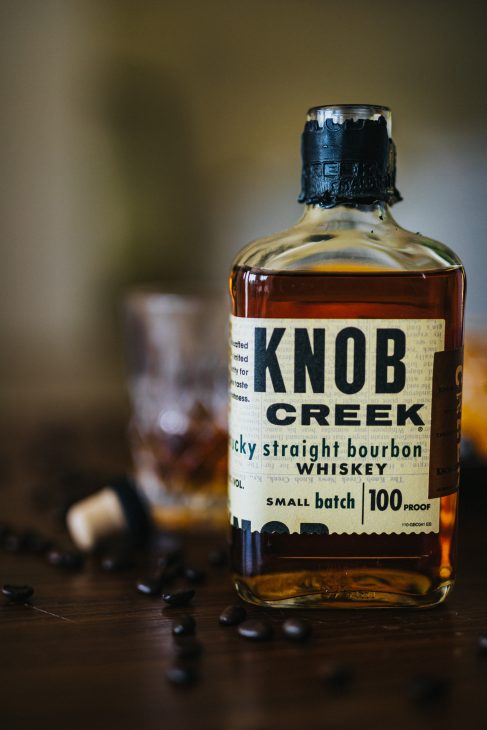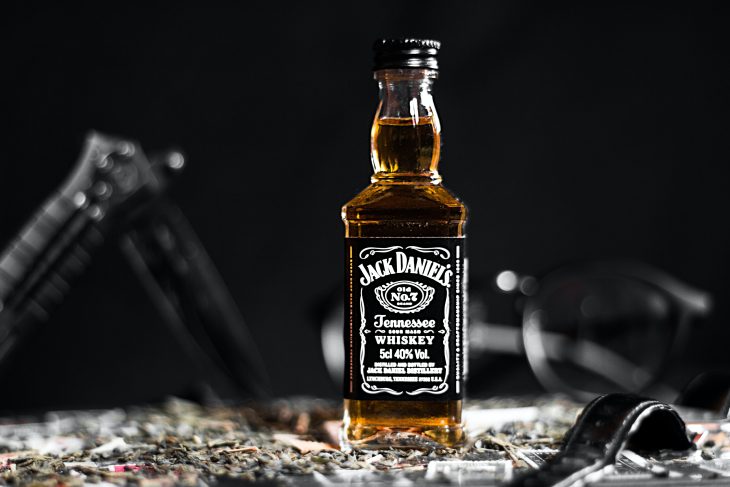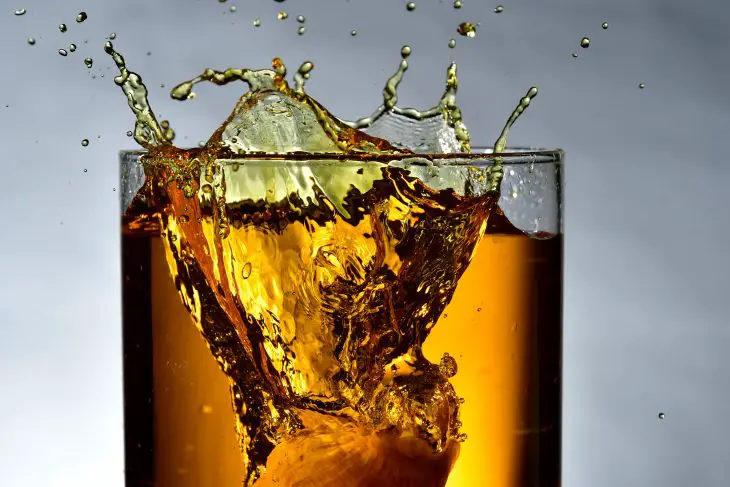Hey there! This site is reader-supported and we earn commissions if you purchase products from retailers after clicking on a link from our site.
All alcoholic drinks seem to have a rather iconic and noticeable color, with some exceptions being vodka, tequila, and other transparent ones. While red wine and white wine are colored by what grapes they use, there is no obvious reason as to why whiskey is the color that it is.
While whiskey colors may vary, such as scotch whisky being darker than a rye whiskey, they all get their color in mostly the same way.

Why Is Whiskey Brown?
The main contributing factor to the brown color of the whiskey is the oak barrels that the whiskey is aged in. The charred oak lining the interior of the barrels gives the whiskey a deep brown color. Some distilleries use an artificial coloring known as E150a, commonly referred to as caramel coloring.
Some whiskeys can come in variations that are as clear as vodka and they will also have a very different taste. The flavor and the color of the whiskey are changed together as you cannot change one without the other one also changing. Unless you artificially color it, of course.
Despite being the same type of alcohol, any change in the production process can change the end result of the alcohol and its color. This is the same with products such as Tequila Silver and Tequila Gold.
Where Does The Brown Color Come From?
The brown hue that you see in whiskey is mostly attributed to the charred oak barrels that it is aged in for a long time. The whiskey acts as a solvent due to the high alcohol content in it which is great for drawing out the tannins, sugars, and pigments from the wood. These are all dissolved into the whiskey and both flavor and color it.
When the weather is warmer, the whiskey naturally expands and is forced into the wood as there is not enough room in the barrel for the whiskey to go anywhere else. When the whiskey is forced into the wood, it is extra effective at taking on all the flavor and color of the wood. Once the weather takes a turn and gets cold, the wood contracts and forces all of the whiskey back into the oak casks. This process is repeated for the entire aging process and does not stop until the whiskey is extracted from the barrel and goes on its way to being sold.
The scotch whisky industry does not always do this, but it is common for some whiskeys to be aged in multiple barrels in their lifetime. This is used to further flavor the whiskey but also ends up coloring it more as well. For instance, some whiskey can be taken from charred oak casks and be placed in sherry casks after a few years to help age them more for a more unique and flavorsome end product.
Bourbon barrels are slightly different from this as they are always brand new. Scotch whisky is always aged in an oak barrel or an oak cask for a premium flavor. These barrels have been reused lots to help with any future flavorings. Bourbon barrels are always newly made and only used once with bourbon. These ex-bourbon barrels will then go on to be used for other whiskeys that can reuse ex-bourbon casks.

The Use Of Caramel Coloring
It is a common theme that whiskey with gorgeous caramel color is more flavorsome and complex, due to its age. Therefore, when people see a whiskey of this color, they are more likely to buy it as it is meant to be good.
Unfortunately, some companies will artificially color their whiskey with caramel coloring to give it the false appearance of being better than it is. Sadly, no company has to mention caramel coloring on their ingredients label which can add some controversy as it is essentially false advertising but without breaking any actual laws.
An exception to this is any bourbon or American whiskeys that use the word ‘straight’ in their title are not allowed to have this caramel coloring as it is illegal. Scotch whisky, Canadian, Irish whiskey, and other American whiskeys are allowed to use this coloring and do not have to state how much they have added if any at all. German distilleries are heavily encouraged to mention their use of caramel coloring by labeling it on the bottle.
What Is The Difference Between Whiskey And Bourbon?
Bourbon is always aged in brand new barrels or charred oak casks that are known as ‘virgin’. Bourbon casks can only be used once for bourbon and are then sold to other distilleries that want to age Scotch or whiskey in them. Scotch is exclusively aged in used casks, most of which are ex-bourbon casks.
If a cask has not been used before, the effects it will have on the drink are a lot stronger when compared to a cask that has been in use for a long time. This is comparable to a tea bag as the liquid will be lighter after each extra use.
This is also a great reason as to why heavily aged whiskeys of up to 12, 18, or 21 years of age are still pretty light in color.
Another common variable to this is also the climate it has been aged in. A whiskey that has been aged in a warm climate does not need to be aged for as long as its cold counterpart. This is because in warm weather the whiskey will increase in size on a molecular level. As the barrel is full, the whiskey will push itself into the barrel where it becomes even more effective at taking on the flavor and pigment of the barrel. This also has an effect on how much whiskey is left in the barrel as some of it is due to disappear thanks to evaporation. A 20-year-aged barrel in Scotland will have a lot more left in it when compared to a barrel in Arizona as the Arizonan barrel will have been a lot hotter so the drink will have evaporated, leaving less whiskey in the barrel.

Can Whiskey Be Clear or Transparent?
Some whiskeys can be sold by a company with a white whiskey appearance or color. To be classed as a whiskey, the drink must be aged in a barrel, although the timeframe is not mentioned. So, smaller distilleries who cannot afford to age their whiskey for ages can get a head start and simply let their whiskey age in a barrel for only a week or two. This allows them to sell it as a whiskey even though it does not have the caramel/amber color that most whiskeys do have.
FAQs On Whiskey Colors
Whiskey is naturally clear when it is made and is only colored after it has been aged in a barrel. The coloring depends on the barrel, although some companies will add caramel coloring to give the whiskey the appearance of being more aged than it actually is.
Before being aged, whiskey is completely clear. The color is only given to the whiskey after it has aged in a barrel for a long time as it dissolves the tannins and pigments of the barrel which is immediately reflected in the flavor and color of the drink.
Some whiskey can appear darker as it has been aged for longer or in a darker barrel. The color is only derived from the barrel or cask that the whiskey is aged in so the darker color is only given by the barrel. Caramel coloring can be used in whiskey, but that is not very dark at all.
Some companies will color whiskey with an artificial caramel coloring in order to give it the appearance of being more aged than it really is. This can be seen as false advertising but there are not many laws against this so nothing can be done about it. The only law is that bourbon and American whiskeys that say ‘straight’ on the label is not allowed to use any colorings that are artificial. The only coloring they can get is from the oak barrels they are aged in.
Recommended Reading
The Number Of Calories And Carbs In Whiskey: A Comprehensive Guide
Whiskey is often considered a more healthy alcohol option. However you may wonder about the number of calories and carbs in whiskey.
Aging Whiskey at Home: A DIY Guide
Aging whiskey at home does not require fancy barrels, licenses, or even mastery in the art of crafting whiskey. All you need is an open mind and some creativity.
What to Mix With Bourbon: The Best Drinks & Creative Cocktails
Having an idea of what to mix with bourbon can not only make bourbon easier to consume but also a more enjoyable experience.
How Many Bottles Are In A Barrel Of Whiskey? [Answered]
Whether you are just curious, or you are wanting to buy yourself a barrel of whiskey - you will ideally want to know how much whiskey there is inside. So, how many bottle of bourbon in a barrel?
Barley Vs Malted Barley: Differences When Making Whiskey
Whiskey is made from a variety of ingredients that all play an important part in how the drink turns out. Some of these ingredients are fermented grains...
Isabella Islay Whiskey – The World’s Most Expensive Whiskey
Isabella Islay whiskey is the most expensive bottle in the world. But what's the big deal? Why does it cost so much?

